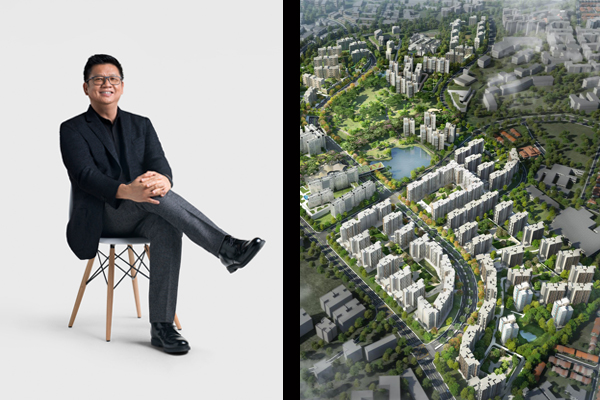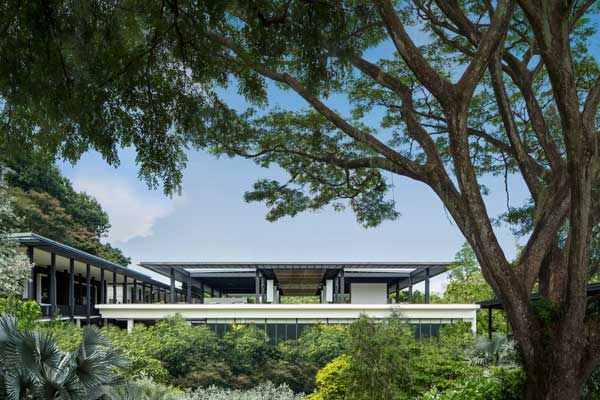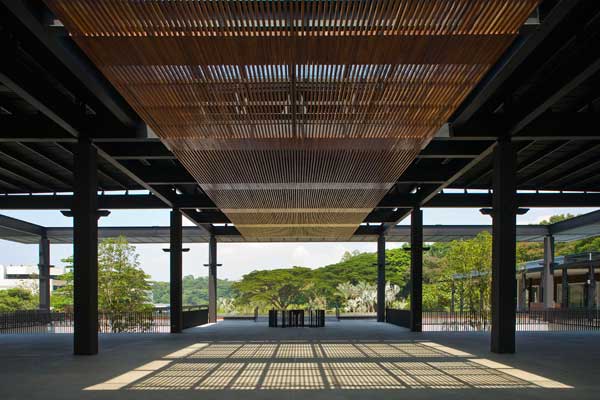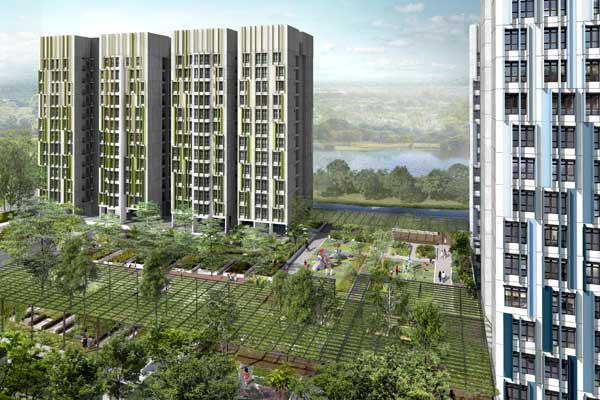Siew Man Kok was recently named “Designer of the Year” at the 2015 President’s Design Award. The 53-year-old architect and his firm, MKPL Architects are also behind the bold master plan for the upcoming Bidadari public housing estate in Singapore, in which housing blocks will be located right within a park. Man Kok takes time out to tell us more about his work and passions.

January 21st, 2016
Top image: (left) Siew Man Kok; (right) master plan for Bidadari Estate, artist rendering

Visitor Centre at Horticulture Park (HortPark)
Your firm’s philosophy is ‘Simple questions that lead to the making of good architecture’. Can you give examples of simple questions you’ve asked that have directly influenced a project?
NUS [architecture school], which I attended, doesn’t [abide by] one single philosophy in architecture. At NUS I met and learned from people with different kinds of philosophies. So in that sense I was exposed to a wide range of thinking, or of looking at architecture. Therefore in practice, I realised that the most important thing was not to jump in to look for the right solution, but to look for the right questions.
For example, with a simple project like the Visitor Centre at HortPark, there were factories on one side, which was not a pretty sight. We were told to do a temporary shed for a visitor centre, and when you take it literally, [the brief is] kind of uninspiring. But on visiting the site and seeing the view of Kent Ridge in the distance, I thought it was quite inspiring and very rare in Singapore’s context. I realised that perhaps the thing we had to ask ourselves was how we could capture this view in the planning of this visitor centre, to reawaken our sense of what Singapore’s tropical climate and landscape is all about. So in that sense the question led us to the solution. Eventually what we designed was a pavilion that [framed] the view [for approaching visitors].
[With this project], through our own questions and enquiry into the programme, and the site, we actually came up with a very interesting, and I would say one of our best works.

Visitor Centre at Horticulture Park (HortPark)
The Bidadari Estate is another example. If you look at all the town parks, they are always across the road from your house. This is because the park is owned by NParks, the road by LTA, and [the public housing] by HDB. With the road serving as the boundary, the management, maintenance and responsibility [for each area] is very clear. But this is just for the purpose of administration. So when we had a chance to master plan Bidadari, and the brief given to us was that there was going to be a park in this housing estate, we asked, ‘Why can’t people live in the park?’
We find that we have to be able to not be blinkered by what we see, by what is practised all the time. We have to go back to basics and ask ourselves the basic questions.

Bidadari Estate (artist rendering)
Weren’t there many challenges to overcome to get your plan for Bidadari approved?
Fortunately, HDB as the driver of the master plan managed to get the buy in from the various [government] agencies. I think Singapore is very lucky in that all the agencies here can work together.
With this project we managed to question old practices, and propose a new way of looking at things. I think Bidadari will eventually showcase this sort of change in thinking that I think will herald a new positive way forward for the future planning of Singapore.
It appears that the attempt to integrate architecture with nature is a constant across your projects – and has been from the firm’s early days. Why has this been a focus for the firm?
I think partly because when we live in Singapore and have so little land, we try to borrow landscape, borrow space, borrow nature… Even your neighbour’s tree can become part of your garden.
In fact we already tried that long ago with a small corner terrace house. There was a roadside tree maintained by NParks. It was right next to the house with the branches coming into the [grounds of the] house, so we built a courtyard around it, and when you look at it from the inside, it looks like the tree is part of the house.
All these examples, having the park [right at your doorstep], bringing the landscape faraway into your view, all these are part of the strategy to stretch your horizon and make you feel that you have more space than you physically own. I think with Singapore’s limited land, you have to sharpen your skill in making sure your environment is still very liveable. And I think if you look around lately, many architects and designers are already making use of air space – not just looking at gardens on the ground, but looking at garden spaces above.
We see skyrise greenery being implemented more and more in Singapore and in other dense urban cities like it. How have you seen attitudes on incorporating greenery into urban spaces change and evolve over the years, and where do you see us heading?
When I started my own firm 20 years ago, most landscape architects only worked on hotel projects. But today, even HDB projects hire landscape architects. So it just shows the attention and focus that people now pay to landscaping. And it is not a coincidence that our work greatly incorporates and integrates with landscaping. In fact, in all our work it’s almost indispensable. We always work with a landscape architect; we always have the landscape concept in mind when we plan the building.
One thing that I think is very critical is that while Singapore’s [urban] density has increased, so too have the amount of greenery. I think it helps to a very large extent to lessen the impact of this very hard kind of urban living environment.
Singapore has embraced vertical greenery like ducks to water, [unlike] many other countries. I think this is something unique to Singapore, and I think it’s partly because the government encourages it, which is good.
What role do feel an architect can and should play in this day and age?
The role of an architect has always been about being an agent of change in any society. [For example if] you talk about greenery, the government can come up with a lot of policies to encourage this, but it’s the architect who really physically and ideologically embraces it and brings it into reality for the developer or the homeowner.
And the other thing of course [in regard to the architect’s role] is social agenda. In our office today, we want to bring good design into public housing estates. While Singapore can be proud of the Marina Bay skyline, personally I want Singapore to be well known for its architecture in public housing – because that’s where 90 per cent of our people live.
If people will travel to see the medieval hill towns of Italy, where people used to live, why can’t we be bold enough to imagine that our public housing estates will one day achieve that same kind of admiration from people around the world, that when they visit Singapore, they would also want to visit a public housing estate.
I think Singapore has come to a point whereby we can look forward to very well designed public housing – not just the buildings, but the public spaces, too.
Siew Man Kok / MKPL Architects Pte Ltd
mkpl.sg
A searchable and comprehensive guide for specifying leading products and their suppliers
Keep up to date with the latest and greatest from our industry BFF's!

Savage Design’s approach to understanding the relationship between design concepts and user experience, particularly with metalwork, transcends traditional boundaries, blending timeless craftsmanship with digital innovation to create enduring elegance in objects, furnishings, and door furniture.

In the pursuit of an uplifting synergy between the inner world and the surrounding environment, internationally acclaimed Interior Architect and Designer Lorena Gaxiola transform the vibration of the auspicious number ‘8’ into mesmerising artistry alongside the Feltex design team, brought to you by GH Commercial.

Marylou Cafaro’s first trendjournal sparked a powerful, decades-long movement in joinery designs and finishes which eventually saw Australian design develop its independence and characteristic style. Now, polytec offers all-new insights into the future of Australian design.

Channelling the enchanting ambience of the Caffè Greco in Rome, Budapest’s historic Gerbeaud, and Grossi Florentino in Melbourne, Ross Didier’s new collection evokes the designer’s affinity for café experience, while delivering refined seating for contemporary hospitality interiors.
The internet never sleeps! Here's the stuff you might have missed

From the trailblazer of Spanish industrial design comes a new collection of recycled rugs – a powerful exploration of the concept of waste, a keen celebration of imperfection, and a new underfoot symbol of responsible design.

Drawing on the concept of a watering hole as a gathering place in nature, GroupGSA has rejuvenated Sydney Water’s headquarters located in Parramatta.